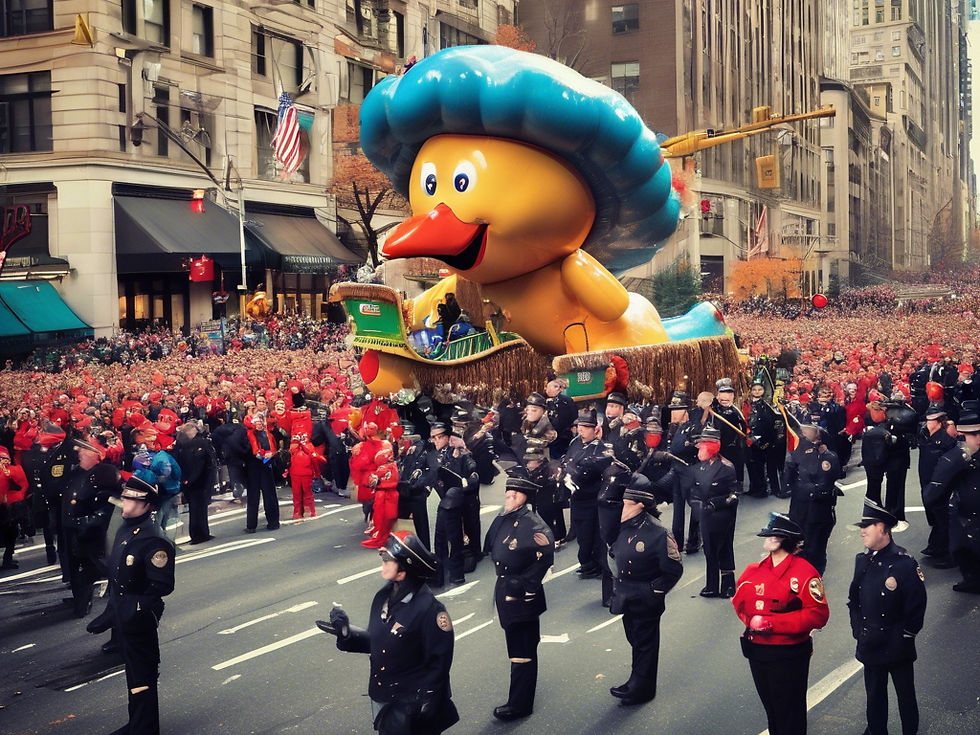How Macy's Thanksgiving Day Parade Became America's Holiday Tradition
- Your VIP Pass
- Jul 28
- 5 min read

Every Thanksgiving morning, millions of Americans gather around their televisions to watch giant balloons float through New York City streets. The Macy's Thanksgiving Day Parade has become as essential to the holiday as turkey and cranberry sauce. But how did this spectacular celebration transform from a simple department store promotion into the most-watched parade in the world?
The story behind America's favorite Thanksgiving tradition spans nearly a century of innovation, resilience, and pure entertainment magic. From its humble beginnings to today's elaborate productions featuring Broadway performances and towering character balloons, the parade reflects both the evolution of American culture and our enduring love for shared celebration.
The Birth of a Tradition (1924-1930s)
The first Macy's Christmas Parade took place on November 27, 1924 — not as a Thanksgiving celebration, but as a Christmas kickoff event. Macy's employees, many of whom were first-generation immigrants, wanted to celebrate the holiday season in the style of European festivals they remembered from their homelands.
That inaugural parade looked vastly different from today's spectacle. Instead of the iconic character balloons we know and love, the route featured live animals borrowed from the Central Park Zoo. Lions, bears, elephants, and camels marched down the streets alongside elaborate floats, creating an almost circus-like atmosphere through Manhattan.
The parade was an immediate success, drawing over 250,000 spectators to line the streets of New York City. The enthusiastic response convinced Macy's executives that they had created something special — a new American tradition was born.
By 1927, the parade had undergone its most significant transformation. The live animals, while spectacular, proved too unpredictable and expensive to manage. Felix the Cat became the first-ever character balloon, ushering in the era of giant inflatable figures that would define the parade for generations to come.
These early balloons presented unique challenges. Rather than the controlled deflation we see today, organizers simply released the balloons into the sky at the parade's end. Macy's even offered rewards for their return, turning balloon recovery into a citywide treasure hunt.
Growing Into a National Phenomenon (1930s-1940s)
The parade's popularity exploded throughout the 1930s, even during the Great Depression. For many American families struggling through economic hardship, the free spectacle provided a welcome escape and reason to celebrate.
Television coverage began in 1939, though it remained local to the New York area. This early broadcast laid the groundwork for what would eventually become one of television's most-watched annual events.
World War II brought the parade to a temporary halt from 1942 to 1944. The rubber and helium needed for balloons were essential war materials, and Macy's patriotically donated their balloon supplies to support the war effort. The parade returned in 1945 with renewed enthusiasm as the nation celebrated both Thanksgiving and victory.
The Television Era Transforms Everything (1950s-1960s)
The 1952 parade marked a pivotal moment when NBC began nationwide television coverage. Suddenly, families across America could experience the magic of the parade from their living rooms. This broadcast accessibility transformed the event from a New York City spectacle into a truly national tradition.
Television coverage brought new challenges and opportunities. Parade organizers had to consider camera angles, television timing, and broadcast-friendly elements. The parade route was adjusted to optimize viewing for both street audiences and television cameras.
The introduction of Broadway performances in the 1960s added another layer of entertainment value. Musical theater acts brought professional-level performances to parade floats, creating memorable moments that television audiences particularly enjoyed.
Innovation and Expansion (1970s-2000s)
Each decade brought technological advances and creative innovations. Balloon designs became more sophisticated, incorporating better materials and more complex shapes. The parade introduced helium management systems that allowed for better control and safety.
Celebrity participation increased dramatically during this period. Musicians, actors, and television personalities began appearing regularly, turning the parade into a showcase of popular culture. These celebrity appearances helped maintain the parade's relevance across changing entertainment trends.
Safety protocols evolved significantly after several weather-related incidents. Wind measurement systems, balloon handling procedures, and emergency protocols were developed to protect both participants and spectators.
The parade's economic impact on New York City grew substantially. Hotels, restaurants, and tourism industries began planning entire Thanksgiving weekend experiences around the parade, generating millions in revenue.
Modern Marvel and Digital Age (2000s-Present)
Today's Macy's Thanksgiving Day Parade represents the pinnacle of event production and entertainment coordination. The parade features approximately 50 balloons, 30 floats, 12 marching bands, 700 clowns, and numerous celebrity performers.
Behind-the-scenes operations have become incredibly sophisticated. Balloon inflation takes place the night before at the American Museum of Natural History, creating its own tourist attraction. Thousands of volunteers undergo training to safely manage the massive balloons through city streets.
Digital technology has revolutionized parade coverage. Multiple camera angles, aerial shots, and interactive online features allow viewers to experience the parade in ways unimaginable to earlier generations. Social media integration lets millions share their favorite moments instantaneously.
Environmental considerations now play a significant role in parade planning. Organizers have implemented sustainability measures for float construction, balloon materials, and waste management throughout the event.
Cultural Impact and Legacy
The Macy's Thanksgiving Day Parade has become more than entertainment — it's a cultural touchstone that brings families together and marks the official beginning of the holiday season. For many Americans, watching the parade represents their first Thanksgiving memory and continues as a cherished family tradition passed down through generations.
The parade has also served as a mirror of American society, reflecting changing values, popular culture, and national moods. During challenging times, the parade has provided comfort and continuity. During celebrations, it has amplified joy and national pride.
International recognition has grown as well. The parade now attracts visitors from around the world who travel to New York City specifically for this experience. Its influence has inspired similar celebrations in other cities and countries.
Experience the Magic Yourself
While millions enjoy the parade through television coverage, experiencing it in person offers an entirely different level of excitement and wonder. The scale of the balloons, the energy of the crowds, and the festive atmosphere create memories that last a lifetime.
Your VIP Pass (YVP) has been creating unforgettable Macy's Thanksgiving Day Parade experiences for over 30 years. Rather than standing in cold streets for hours with limited views, YVP offers premium viewing experiences at carefully selected restaurants along the parade route.
These exclusive packages include heated indoor locations, gourmet dining, private viewing areas, and guaranteed sight lines of the parade. From Quality Italian's front-row street-level viewing to Stella Trattoria's elevated windows inside Macy's Herald Square, YVP ensures comfort while maximizing the spectacle.
The benefits extend beyond just better views. YVP experiences include professional event coordination, restaurant partnerships, and seamless logistics that eliminate the stress of navigating crowded streets on parade day. Families can focus on enjoying the tradition together rather than worrying about bathrooms, food, or finding good viewing spots.
For those seeking to transform their Thanksgiving tradition from television viewing to in-person wonder, Your VIP Pass offers the perfect solution to experience America's greatest parade in comfort and style.




Comments